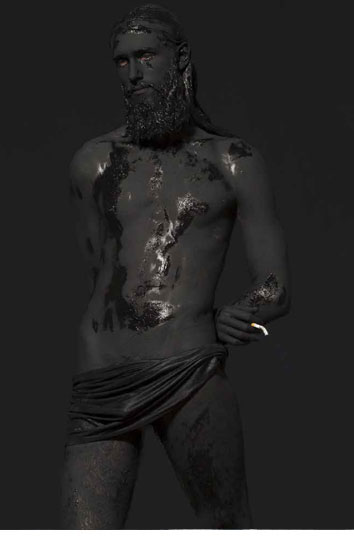FLEWID VOLUME ZERO
Interview Valeria Montebello

Being watched and watching are the commandments of our time. Exhibitionism and voyeurism can no longer only be considered as the perverse goal of the libido. Life is at stake in this pleasure of being watched and watching. And nakedness is the pinnacle of this movement towards this act of showing. Valéry wrote that “what is most profound in man is his skin.”
The skin in Mustafa Sabbagh’s photographs shows his most radical nudity, that which has nothing to say, which alludes to nothing; it is simply a glow, an instantaneous appearance. The work of a skin-deep photographer, a seam stitcher, is just that: to lead the eyes to look at a truth that is written directly on the skin, one which is reticent to mediation and explanations.
Skin that is painted black, barriers that are breaking down, borders that are redefined. In his travelling retrospective exhibition (baptized in Palermo, its second leg opening in Forlì on October 14), which recites the “XI Commandment: Thou shalt not forget”, the skin continues to write its ever-immemorial story, as it is looked at and immediately forgotten.
The colour black, covered faces, transfigured images. Where is your research headed?
In so many directions. I often seek a crossroads: one road leads me to my true self, the other leads deeper, in an attempt to understand the slavery of modern man – being inside the multitude, being identical to all the other faces one meets every day.

Can we still talk about a “photography project” or does research just lead where it leads, without a definite goal?
Life is a project, if you investigate life and follow the project. That said, as you proceed with a project, you are often led towards unexpected destinations…
How does the creative process begin?
Unconsciously as well as consciously. Dematerializing actions ideologically with a gesture as they pass through your mind. Understanding. Our brains are dependent on art/facts, ideas, and ways of thinking, which we derive from culture, which is summed up by language. I would call it “individual software”: this is, for me, a moral project.
Are your works always the same as you originally imagined them to be?
Exactly the same. I only use language to remodel my brain so that I can reflect on how to get to the goal I have set myself.
Showing the skin but also, at the same time, using various tricks to hide it. Colours, fabrics, applications. What is the skin for you?
If the brain is our software, the skin is a microchip. All the data are recorded on the skin.
Art has lost its sacredness. Hearing sacredness, spirituality, or inspiration being talked about makes me wince. But the artist, traditionally, was the one who was inspired by the muses, the gods, God. What do you think?
You have to love art by accepting the fact that you are not able to understand it. That is the contemporary idea of faith. Thinking that the artist’s job is to set off revolutionary processes has led art to become a concept that is too earthy. I prefer the sacrosanct dogma: art for art’s sake.

When you take photographs, do you think about a certain type of public? If so, whom?
Being an onanist, the public only interests me at the theatre.
Do artists have to explain what they see and do in order to enter the market, to obtain a place there? Must they show that they are mindful of their work? Or don’t they need to; are they like a lantern lighting the way, understanding something about their time, and creating a work with that something… and only later will the theorists come to provide an intellectual opinion, to explain it, and save their work?
Neither one nor the other: true artists only follow their own vision, their own path, without worrying about providing indications. True artists are like salmon; they go in the direction they think their art will be most productive. True artists don’t care about the direction the current is flowing; they go where they can lay down their truths.




